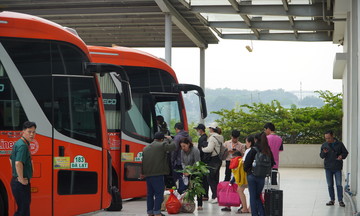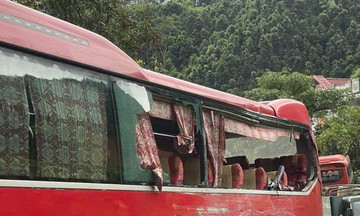Ho Chi Minh City's future as a 'megacity' after the merger
After merging with Binh Duong and Ba Ria - Vung Tau, the new Ho Chi Minh City will become Vietnam's first megacity, presenting both potential and challenges.
From 1/7, three key areas of the "Southeastern Key Economic Zone," including Ho Chi Minh City, Binh Duong, and Ba Ria - Vung Tau, will officially merge to form the new Ho Chi Minh City. According to General Secretary To Lam, this marks an unprecedented turning point in the history of Vietnam's urban development.
Increased scale, increased pressure
The merger of three of the six leading localities in terms of economic scale in Vietnam will reinforce Ho Chi Minh City's leading position, which has weakened in recent years. According to the Ho Chi Minh City Institute for Research and Development (HIDS), the new city's post-merger economic scale will reach over 2.7 quadrillion VND—nearly 25% of the country's 2024 GDP. The new city's budget revenue will also be significant, accounting for nearly one-third of the nation's total at 682 trillion VND.
Before the merger, Ho Chi Minh City was primarily a service-oriented city, with the service sector contributing over 65% to the locality's 2024 GRDP. The economic structure of the new Ho Chi Minh City will shift as the proportion of industry increases, thanks to the strengths of Binh Duong and Ba Ria - Vung Tau. The service sector's share will decrease to 51.82%, while industry and construction will increase from 22% to 35%, with the remainder coming from agriculture, forestry, fishery, and product taxes.
The new Ho Chi Minh City also possesses advantages in infrastructure connectivity with other provinces within the country and cities in the region.
After the merger, five provinces and cities will have two airports serving civilian purposes: Ho Chi Minh City, Da Nang, Gia Lai, Dak Lak, and An Giang. Ho Chi Minh City will have Tan Son Nhat International Airport and Con Dao Airport, with a total capacity of about 51 million passengers annually, the largest in the country, serving as a driving force in tourism and freight transport development.
In the future, this megacity will also be directly linked to Long Thanh International Airport (with a capacity of 50 million passengers per year) via a system of expressways and metro lines.
Furthermore, inheriting the logistics system from Ba Ria - Vung Tau, the new Ho Chi Minh City will possess Vietnam's largest seaport system with 89 wharves across three port systems, including a world-leading deep-water port at Cai Mep - Thi Vai.
However, the new Ho Chi Minh City will also face many challenges following the merger and the transition of government administration from three levels to two.
With 168 wards and communes, Ho Chi Minh City will have the most basic administrative units after the merger, including six of the 10 most populous wards and communes nationwide. Ho Chi Minh City also has 9 of the 10 wards and communes with the highest population density in the country.
The demographic challenges were also addressed by General Secretary To Lam during his meeting with Ho Chi Minh City's authorities. The large population size and high density in some areas will pose challenges for urban planning, putting pressure on infrastructure and limiting living space.
In addition, the city faces flooding, traffic congestion, and low scores on the Provincial Competitiveness Index (PCI) and the Provincial Governance and Public Administration Performance Index (PAPI), which reflect citizen satisfaction.
Meanwhile, the reduction to a two-tiered government means provincial leaders will have to work with more stakeholders.
Dr. Architect Le Quoc Hung, Deputy Director of the National Institute of Urban and Rural Planning, believes this will be a significant challenge for department-level officials. Previously, they only had to work directly with about 20 stakeholders, but now that number is 168. Numerous basic administrative units also create difficulties for planning and implementation due to excessive fragmentation. To address this, he suggests forming development zones based on clusters of wards and communes.
Vietnam's first "megacity"
According to the United Nations Department of Economic and Social Affairs (UN DESA), cities with over 10 million inhabitants are classified as megacities. Thus, with a population of 14 million after the merger, the new Ho Chi Minh City will become Vietnam's first megacity and the fourth in Southeast Asia, after the Bangkok Metropolitan Region (BMR, Thailand), Jakarta (Indonesia), and Metro Manila (National Capital Region, Philippines).
UN DESA ranks megacities and megaregions together. Megaregions are formed by connecting adjacent cities with a national "capital" as the core. For example, the Bangkok Metropolitan Region includes Bangkok and five adjacent provinces, while Metro Manila connects nearly 20 highly urbanized cities.
Compared to other megaregions in the area, the new Ho Chi Minh City's economic scale still lags, at about 64% of the Bangkok Metropolitan Region's GRDP and 47% of the Jakarta Metropolitan Area's. However, the population density of the new Ho Chi Minh City is lower than that of the region.
These urban areas share a common feature: they have developed modern public transport systems connecting the center to satellite areas. For instance, Bangkok is connected to five neighboring provinces by three BTS Skytrain lines with a total length of nearly 70 km, along with the MRT subway system, the BRT bus rapid transit system, and the Airport Rail Link.
While there is a master plan for the Southeastern region, the connectivity between the former Ho Chi Minh City core and the satellite cities of neighboring provinces remains inadequate, from roads to urban public transport.
According to Dr. Tran Du Lich, former Director of the Ho Chi Minh City Institute of Economics, despite having regional development guidelines, the area has not fully realized its potential due to weak connectivity and differing approaches among localities.
"The merger will bring the three provinces together in one direction, fully exploiting the potential previously limited by administrative boundaries," Dr. Lich assessed.
Before the merger, Ho Chi Minh City was the nation's leading economic hub, but its regional and international influence remains limited.
In 2024, AT Kearney, a leading global consulting firm based in the US, ranked Ho Chi Minh City 102nd out of 156 global cities, down eight places from the previous year. Kearney's ranking is based on five dimensions with 31 indicators to assess a city's international connectivity and influence (global city). These influences can impact various aspects, such as attracting capital, talent, and innovative ideas.
Regionally, other major cities like Singapore, Bangkok, Kuala Lumpur, Jakarta, and Manila are all ranked within Kearney's top 100. Meanwhile, Ho Chi Minh City's low rankings in cultural experience and political activity affected its overall score.
However, Ho Chi Minh City has made strides on the global startup map. Since 2020, Ho Chi Minh City has climbed 115 places in the global startup ecosystem rankings, according to StartupBlink, a global startup research platform. In its latest report, StartupBlink ranked Ho Chi Minh City 110th, surpassing Manila and approaching the global top 100.
Professor Dr. Nguyen Trong Hoai of the Ho Chi Minh City University of Economics assesses that compared to existing global cities in the region and worldwide, Ho Chi Minh City still has some catching up to do. However, after the merger, the economic advantages of all three existing localities will be leveraged through a shared planning vision. This will provide the new Ho Chi Minh City with more opportunities to develop into a global city, narrowing the gap with other cities in the region, starting with economic scale.
"The new Ho Chi Minh City must broaden its vision. When we talk about regional connectivity, it will no longer be limited to within the country as before, but must include regional and global connections. This is the way to make the new Ho Chi Minh City a global city," said Professor Hoai.
In meetings with the city, General Secretary To Lam also requested that the new Ho Chi Minh City become an international megacity in Southeast Asia with global influence. The goal for 2035-2045 is for the city to be among the top high-income cities in Asia, a top 30 financial center, and a top 50 smart and livable city in the world.
Quang Tue - Dang Nguyen












